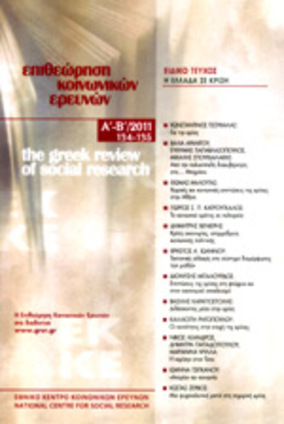Zwei beitrage zum problem der bevolkerungsstruktur von Gross-Athen
Part of : Επιθεώρηση κοινωνικών ερευνών ; Vol.9/10, 1971, pages 115-131
Issue:
Pages:
115-131
Section Title:
Articles
Author:
Abstract:
As a contribution to the step by step clarification ofthe difficult and complex demographical conditions ofGreater Athens two results of an investigation concerningthe population structures of 50 of the 57 communitiesbelonging to the agglomeration will be shown :1 ) some remarks on the distribution of the immigrantsof the years 1951 - 1961 within the agglomeration;2) a typification and local articulation of the demographicalstructures of Greater Athens.Part I : Basis of the investigation are the results ofthe population censuses of 1951 and 1961 published bythe National Statistical Service of Greece, which allowwork with exact and large figures. However, due tothe insufficient questionnaires as well as to the mannerof publication, the material is not sufficiently differentiatedwith regards to the factors of investigation andthe local articulation. (An example: the figures werepublished only for administrative units as a whole,without considering—at least with regards to thelarger communities—necessary further split-ups).Thus on this basis investigations on the populationstructures can only lead to insufficient results. Weshall be restricted to these preliminary results untilthere will be published differentiated and more completematerial which will also satisfy the needs ofthe population geographer.Part II : The population inflow adds a great dealto the rapid growth of Greater Athens. Because ofthe decisive impact of population inflow on the populationstructure of a town generally, it is desirableto know the repartition of the immigrants within theagglomeration of Athens. However, exact figures ofthe immigrants in the different communities are notavailable. The author depicts a method according to which figures of the immigrants of the years 1951 -1961 can be calculated upon:1) Population of 1951 plus population 1961 dividedby 2 shows the average population of 1951/61:2) Average population 1951/61 divided by 1.000multiplied by the natural increase rate of 1961 multipliedby 10 shows the absolute natural population increaseof 1951/61:3) Population 1961 minus population 1951 minusabsolute natural population increase 1951/61 showsthe approximate absolute number of immigrants.Based on this method fig. 2 gives the relative shareof the immigrants in the total population of eachsingle community. However, this method involvessome problematic factors which can only be eliminatedto a certain extent and of which the most importantare : the rates of the natural population increase canonly be fixed for the year 1961, inner-town mobilityis unknown to a large extent, and others. Theresults which are attained by this method can be only regarded as estimates (see legend fig. 2). Taking intoaccount these sources of possible error, it is completelyimpossible to make statements on some of the communities.This is followed by a short interpretation offig. 2.Part III : Typification and local repartition of thedemographical structures of 50 communities ofGreater Athens. Because of the insufficient statisticalmaterial, the results can be regarded only as an attemptto enable a first orientation. By particular analysis(not related in this paper) the different structures ofthe communities were examined. By a comparativeexamination of these particular analysis and a combinationof their results those districts of Greater Athenswere determined upon, in which communities provedequal or very similar in their population structure(fig. 3). Based on the statistic material the followingitems could be included in the analysis in particular(commented upon in the essay with regards to theirusefulness and completeness): structure of age, naturalpopulation mobility, repartition of sex, percentage ofeconomically actives (separately for men and women),education (percentage of illiterates), immigration (seepart II, plus the economic activity of the immigrants1956-61), population increase 1951-1961, housing conditions(equipment of the localities). The table willenable one to imagine the numerical value of the termswhich are used in the interpretation of fig. 3 «low»,«middle», «high». Main types of population structureare distinguished (A - D), which are themselvessplit up in various sub - types (pointed out by figures,e.g. A/l, A/2) respectively special types (e.g. A/2.1).Some extreme cases (ax - d) which can be added toseveral types are treated separately.The full interpetation of fig. 3 is condensed toa short characterization of the 4 main types : type Asignifies a young, dynamic population of lower socialstatus, which mainly consists of recent immigrants.The structure of this population shows typical symptomsof badly integrated immigrant-regions, asthey often develop at the outskirts of quickly growinglarge towns. The most extreme samples are to be foundin the sub - type A/l. Type B, too, is to be found inonly recently populated regions. However, there isan older, well settled population of upper and middleclass citizens in more preferable residential areas. Thenumerous feminin service personnel—mainly immigrants—represent an important factor in the population.Type C is located in communities of the interiorparts of the agglomeration, which are densely andalready for a long time populated. It consists of anolder, fixed, and long established population ofmost different social classes, stagnating in its development.Certain variables vary greatly among the differentsub-types. Type D consists of a region whereonly recently were still rather rural suburbs of Athens. This part most likely will be very important for thefuture development of the agglomeration; the structuresof the still fixed, older middle-class populationsof these communities are undergoing differentphases of strongly transforming developments.The future development tends on one hand towardsthe conditions of the immigrant - regions type A/3,on the other hand—in the regions of especially beautifulscenery—towards an approach to type B. Theextreme cases result of the overlapping of populationstructures in adjoining regions. They thus could atthe same time be taken to several population types.The last table shows—only for an orientationn—in which items they come closest to which types.
Subject:
Subject (LC):




